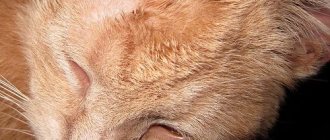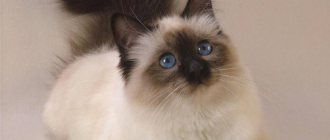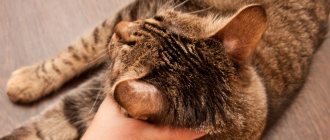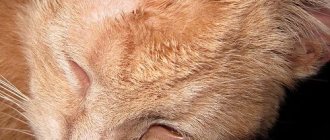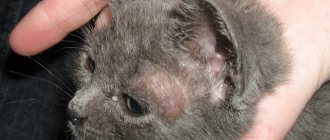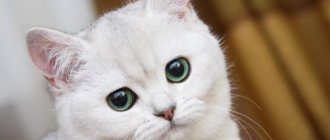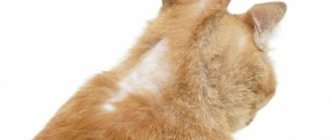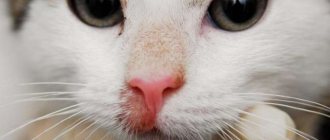May 19, 2020
Dermatophytosis (commonly referred to as “ringworm or ringworm ”) is a disease of humans and animals caused by pathogenic fungi that affect the skin and its appendages (fur, claws).
For nutrition and growth, these fungi require the protein keratin, so they infect keratinized tissues. This disease is quite common in humans, but it is caused by another pathogenic fungus. The predominant human pathogen Trichophyton spp.
The most common animal pathogens are Microsporum canis (the most common species, especially in cats), Microsporum gypseum (geophilic, found in soil) and Trichophyton mentagrophytes (usually carried by rodents). They are found all over the planet. Accordingly, diseases caused by Microsporum are called “microsporia”, and Trichophyton, “trichophytia”. The general name, accordingly, is “dermatophytosis”.
Ringworm in humans
Dermatophytosis is a zooanthroponosis, that is, a person can become infected from a cat or dog, less often through contact with care items, grooming supplies, and the environment. It is extremely rare, but not impossible, for animals to become infected from humans.
Ringworm in children and adults most often appears as hairless areas with a hyperemic rim and peeling and scales in the center, which are most often localized on the head, arms and other parts of the body. The itching is usually not severe.
The disease is very contagious (infectious), and therefore often has the character of an epidemic within a family.
Diagnostic measures
Clinical signs may indicate the possibility of dermatomycosis, but they are often not that specific. Other techniques are commonly used, among which one of the most common is the Wood's Lamp. This lamp emits ultraviolet light with a specific wavelength. Infected hair and skin areas begin to fluoresce. Everything would be fine, but there are some nuances:
- No more than 50% of pathogenic fungal species show fluorescence.
- Some medications or other preparations, when applied to the skin and coat, can also cause this phenomenon.
Predisposing factors for the development of the disease in humans
- Age (usually children)
- Immune status (people with a reduced immune status get sick more often)
- Lesions, microtraumas on the skin
- Oncological diseases
- Chemotherapy use
If you got a kitten or a puppy, and not necessarily taken from the street, the chance of buying a sick pet in expensive nurseries is about the same, and after some time you notice the appearance of lesions on the skin, be sure to consult a dermatologist! Take your pet to the veterinary clinic for an appointment and diagnosis with a veterinary dermatologist.
Prevention measures
It is impossible to completely protect your pet from lichen. The dog is always in contact with the environment, which may contain particles of fungal microorganisms. The owner can only reduce the risk of dermatophytosis if he follows the following rules:
- do not allow your dog to come into contact with street animals;
- feed the animal a balanced diet;
- treat all other diseases in a timely manner;
- visit the veterinarian regularly, even if the dog is not bothered;
- bathe the animal with antifungal agents, but without fanaticism - too frequent water procedures weaken the protective functions of the skin.
Preventive measures are mandatory in animal shelters and foster care facilities. If one dog becomes infected, dermatophytosis will quickly spread to all the others.
Methods of infection
- Direct contact with a sick animal.
- Contact path through the environment (less common). For example, in nurseries, shelters, pet hotels, hospitals, when breaking up the soil, etc.
- Through care items (brushes, combs, clippers, etc.) for microtrauma of the skin.
Infectious forms are called "arthrospores", which are formed from fragments of fungal hyphae. These spores enter through microtraumas of the skin. Within 6 hours the disease begins to develop. After 5-7 days, the first clinical signs can be noticed. Arthrospores can remain outside the host's body for up to 18 months. It is important to remember that not all animals may have clinical manifestations; some cats are simply carriers of the disease.
The hair growth cycle influences the development of infection. At the telogen stage, spontaneous recovery is possible.
Which species of cats and cats are at risk of infection with dermatophytes?
People at risk for dermatophyte infection include:
- Young individuals (under the age of one year) and older ones (over 10 years old). Kittens are at greater risk of infection due to their immature immune systems. A formed immune system allows adult animals to be more resistant to any infections.
- Animals that are sick with cancer or chronic diseases.
- Fur of Persian and Himalayan cats. The fur of long-haired cats and cats, much faster than short-haired cats, can become a “soil” for the life of spores of a fungal infection.
- Cats and kittens in homeless shelters and nurseries when kept in poor living conditions.
Clinical signs
Clinical signs may vary and are not always specific! This is why it is impossible to make a diagnosis based on clinical examination alone. One or more studies are required.
- Lesions can be both superficial and deep (including lesions of the hair follicles).
- Various combinations of alopecia, papules, scales, crusts, erythema (redness of the skin), follicular casts and hyperpigmentation. Alopecia in this case is usually spontaneous (appearing independently, and not as a result of licking). This occurs due to damage to the hair follicles.
- The lesions are asymmetrical.
- Itching is usually mild.
- In cats, lesions most often occur on the head, nose, ear, area around the eyes, and less often in other areas. In dogs, on the head, auricle, nose, less often on the body, on the fingers, and claws. In dogs, there is a very specific manifestation of dermatophytosis - localized alopecia with clear borders, called "kerion". But a generalized form of the disease, when lesions are widespread, is also possible. Sometimes, the disease can be complicated by pyoderma (inflammation of the skin).
Symptoms of ringworm
During the incubation period, humans can infect cats.
Dermatophytosis is an extremely contagious disease that can be transmitted from one animal to another, and then to humans. The infection can persist in the pet’s body for up to 6 years and not reveal itself in any way. During the incubation period (8-22 days), the fungus actively develops and spreads, although symptoms of the disease do not appear. Therefore, the animal is capable of infecting people and other pets.
As the disease progresses, cats' fur becomes brittle and round bald patches form. They are localized in the head area (on the ears, crown) and at the tip of the tail. Sphynx cats develop red sores on their bodies. At first these may be small foci of the disease, which later merge into one spot. Bald spots are not always noticeable in long-haired breeds, as they are hidden behind the hair. The skin takes on a grayish tint and begins to peel off. The affected areas are itchy and cause discomfort to the cat. Suppurations appear, which later become scars. Without treatment, dermatophytosis can lead to inflammation of the hair follicles.
Diagnosis of ringworm
- Examination using a Wood's lamp, also known as LUM diagnostics. According to various sources, from 50 to 90% of Microsporum canis strains glow emerald green under ultraviolet light. The study is carried out with a lamp heated for 5 minutes in complete darkness.
Hairs exhibiting such a glow are additionally examined under a microscope or sent for inoculation on dermatophytes. This study cannot serve as a basis for making a diagnosis, since some creams, sprays, and skin treatments exhibit glow. - Trichoscopy. Microscopy of the affected hair under a microscope. As a rule, hairs that exhibit glow under a Wood's lamp are examined. The study is carried out under 40x magnification. Affected hairs usually have a characteristic appearance: keratin clumps are destroyed, the structure of the hair is changed, and a large number of dermatophyte spores are on the surface. This method is also not 100% specific.
- Skin biopsy. In case of deep skin lesions. Under general or local anesthesia, the doctor cuts off a piece of the affected skin and sends it to the laboratory for examination by a histologist.
- Sowing on special nutrient media followed by microscopy of grown colonies. Only this method can accurately determine the pathogen! It is considered the “gold standard” of diagnosis. The wool must first be treated with 70% alcohol to prevent the growth of mold fungi. The disadvantage of this method is that colony growth occurs within 21-28 days. Macroconidia are then assessed by microscopy and the causative agent is identified. There are also express media in which colonies grow faster, within a few days.
- PCR (polymerase chain reaction). The laboratory searches for DNA fragments of the pathogen.
How is it diagnosed?
To determine the form of the disease, a biopsy is performed. To identify a specific type of fungus, a microscopic examination of the cat's fur is prescribed. The most effective method of study is fungal culture. This is a method of determining the source of the disease by placing scraping samples in a special solution and observing them for a week. In rare cases, a Wood's lamp is used. This is a way to study integument using green fluorescent light. It should highlight the affected areas. But in 50% of cases the lamp gives an inaccurate result.
Treatment of ringworm
Depending on the severity of the infection, the nature and extent of the lesions, local or systemic therapy is chosen.
Local therapy
- Using a 2% solution of lime sulfur (Lime-Sulfur shampoo) once a week. Non-toxic to small puppies and kittens and can be used as monotherapy. The disadvantages of using it are that the pet must be washed completely using gloves; it is forbidden to dry it with a towel or hairdryer, that is, let it dry on its own. At the same time, the drug has an unpleasant odor of hydrogen sulfide and colors the wool green-yellow.
- Imaverol (enilconazole) or Liverazol-drug is diluted 1:50 and used once every 3-4 days. It is also safe for small kittens and puppies. Its dilution of 1:100 is allowed for environmental treatment.
Systemic form of treatment
In the absence of improvement or generalized form of lichen, a systemic form of treatment is used.
- Griseofulvin is an antifungal antibiotic. Quite an old and practically unused drug. May be toxic, so its use is very limited. It should not be used during pregnancy, anemia, chronic viral infections of cats, or liver pathologies.
- Ketoconazole An antifungal drug, a derivative of Azoles. Used for the treatment of dermatophytosis and other fungal diseases of dogs, such as Malassezia dermatitis and otitis media, candidiasis, blastomycosis, cryptococcosis, etc. Not used in cats due to its hepatotoxicity.
- Itraconazole Also a derivative of Azoles, but with a wider spectrum of action and less pronounced toxic effect. Allowed for cats.
- Fluconazole The effect is similar to Itraconazole, but this drug has higher bioavailability.
- Terbinafine The most commonly used drug for the treatment of lichen in cats. Allowed for use during pregnancy.
Systemic therapy
As a rule, dermatophytosis in cats is treated with topical medications within three weeks. If therapy does not produce results, then the doctor decides to prescribe a systemic course. It has side effects, so you need to be treated under the supervision of a specialist, taking regular blood tests. This is necessary in order to track the number of white blood cells.
The duration of the course of taking systemic drugs is one and a half to two months. It may include Itraconazole or Griseofulvin. The first is prescribed in an amount of 10-20 mg. Take it either every other day or daily. The dosage of the second drug is 25-60 mg/kg. Cats are given it 1-2 times a day. Itraconazole is considered less toxic. It is more easily tolerated by animals and rarely causes side effects.
These drugs can disrupt development, so they should not be prescribed to kittens under three months old and to individuals who are expected to give birth.
If the fungal infection has spread to the claws, then Flucostat, Fluconazole, and Diflucan are prescribed. These drugs are quite effective. Dosage – 20-30 mg once a day.
Environment
It is very important to treat the environment correctly and thoroughly! After all, spores spread with the animal’s fur throughout the apartment.
For clothes, blankets, beds, it is recommended to wash them with boiling water or at 90 degrees, then carefully iron them or use a steam generator.
To treat premises, use Liverazol at a dilution of 1:100 or a 3-4% solution of Chlorhexidine. It is recommended to vacuum and wash the room daily. It is recommended to trim or shave the affected areas on your pet's skin. Animals with confirmed infection must be isolated from other pets. If there are a lot of animals in the room, it is recommended to use medicated shampoos or Liverazol for prevention.
ethnoscience
Some owners use herbal medicine to combat dermatophytosis in cats. When treating at home, it is recommended to use a collection of herbs. It should include:
- birch leaves;
- St. John's wort;
- sagebrush;
- medicinal marigolds;
- Oak bark;
- marsh cudweed;
- meadow clover;
- tansy (inflorescences);
- yarrow;
- dried sage leaf;
- chamomile (flowers);
- burdock leaves.
An infusion is prepared from this herbal collection. To do this, pour boiling water over the mixture. Dosage – 0.5 l per tablespoon. The maximum infusion time for the decoction is 3 days. For prevention, the animal is given 4-5 ml before feeding 30 minutes. Sick individuals take 8-10 ml 2-3 times a day.
If this pathology causes ulcers or wounds to form on the cat’s body, then you can use calendula infusion. It promotes rapid healing.
It is possible to defeat parasites!
Antiparasitic Complex® - Reliable and safe removal of parasites in 21 days!
- The composition includes only natural ingredients;
- Does not cause side effects;
- Absolutely safe;
- Protects the liver, heart, lungs, stomach, skin from parasites;
- Removes waste products of parasites from the body.
- Effectively destroys most types of helminths in 21 days.
There is now a preferential program for free packaging. Read expert opinion.
Read further:
Pathogenic fungal spores: detection and destruction on nails
Malassezia in cats: symptoms, routes of infection and methods of treatment for the fungus
Prevention of ringworm in dogs
Medical treatment of dermatomycosis
Conditionally pathogenic microorganisms in men and women: names and photos
Human pathogenic microorganisms in the environment: destruction factors


